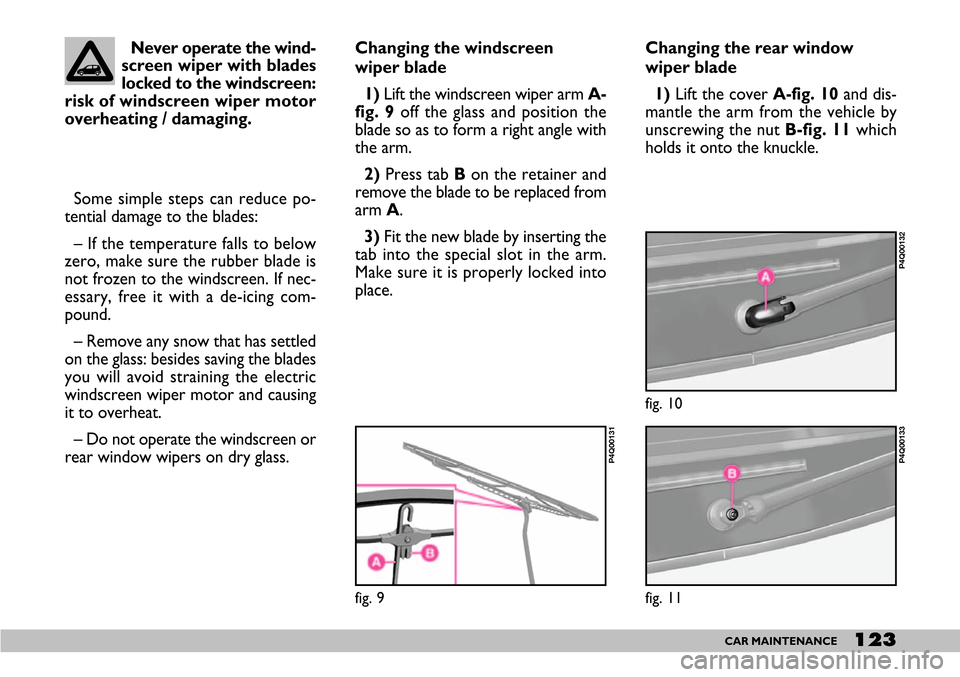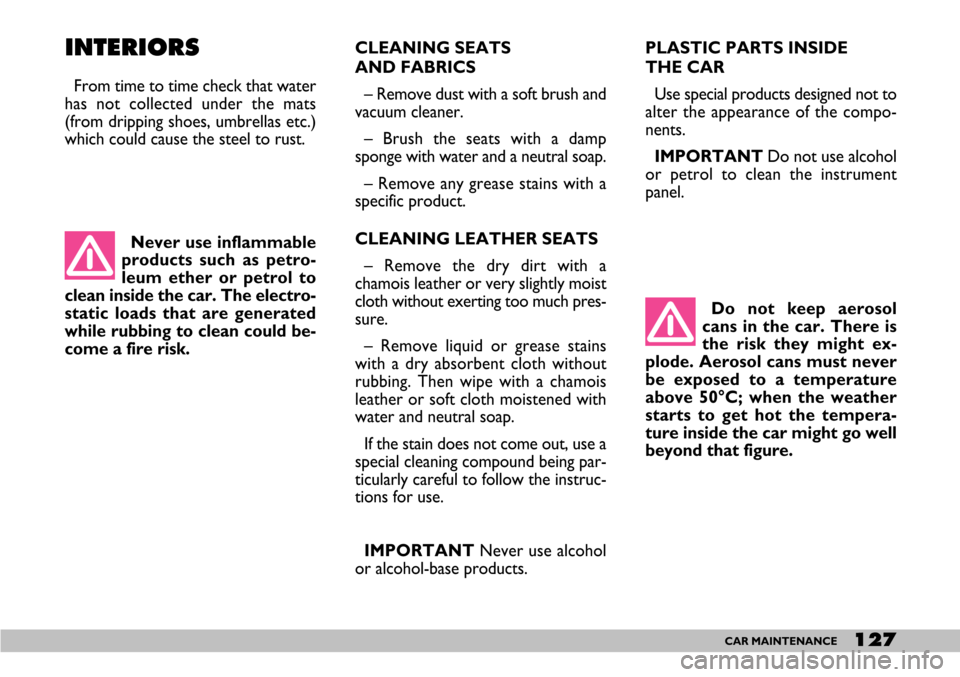Page 95 of 154
94IN AN EMERGENCY
GENERAL INSTRUCTIONS
When a light is not working, check
that it has not fused before changing
the bulb.
For location of fuses, refer to
IF A
FUSE BLOWS
in this chapter.
Before replacing a bulb that does not
work, check that the contacts are not
oxidised.
Burnt-out bulbs must be replaced
with ones of the same type.
Always check the height of the head-
light beam after changing a bulb.
fig. 11
P4Q00160
IMPORTANTOn the inside sur-
face of the headlight there could ap-
pear a slight coat of fogging; this does
not show a defect, since it is a natural
occurrence due to low temperature
and to the degree of humidity in the
air; it will soon disappear as soon as
the lights are turned on. The presence
of drops inside the headlight shows
water seepage, refer to the Fiat
Dealership.
Page 123 of 154

122CAR MAINTENANCE
RUBBER TUBING
Follow the SERVICE SCHEDULEto the
letter as concerns braking, power
steering and fuel line rubber tubing.
Ozone, high temperatures and long
absence of fluid in the system can in
fact cause the hardening and cracking
of the pipes with possible loss of fluid.
A careful check is therefore essential.
WINDSCREEN AND
REAR WINDOW
WIPERS
BLADES
Periodically clean the rubber part
with suitable products. We recom-
mendTUTELA PROFESSIONAL
SC35.
Change the blades if the rubber edge
is warped or worn out. You should in
any case change them approximately
once a year. who can judge whether they are still
fit for use. Remember to check the
spare tyre particularly carefully too.
If a replacement is necessary, always
use new tyres and avoid using ones
the origin of which you are not cer-
tain about.
The Fiat 600 fits tubeless tyres. Un-
der no circumstances use an inner
tube with these tyres.
If you replace a tyre it is a good idea
to change the inflation valve, too.
To ensure the front and rear tyres
all wear evenly, you are advised to
change the tyres over every 10-15
thousand kilometres keeping them on
the same side of the car so as not to
reverse the direction of rotation.
Do not change the tyres
over in criss-cross fashion
by moving a tyre from
the left hand side of the car to
the right and vice versa.
Travelling with worn
wiper blades is dangerous
because it reduces visibil-
ity in bad weather.
In winter if the temperature falls be-
low zero, make sure the blades are
not frozen to the windscreen. If nec-
essary, free them with a de-icing com-
pound.
Page 124 of 154

123CAR MAINTENANCE
Changing the windscreen
wiper blade
1) Lift the windscreen wiper arm A-
fig. 9off the glass and position the
blade so as to form a right angle with
the arm.
2) Press tab B on the retainer and
remove the blade to be replaced from
arm A.
3) Fit the new blade by inserting the
tab into the special slot in the arm.
Make sure it is properly locked into
place.Changing the rear window
wiper blade
1) Lift the coverA-fig. 10and dis-
mantle the arm from the vehicle by
unscrewing the nut B-fig. 11which
holds it onto the knuckle.
fig. 9
P4Q00131
fig. 10
P4Q00132
fig. 11
P4Q00133
Never operate the wind-
screen wiper with blades
locked to the windscreen:
risk of windscreen wiper motor
overheating / damaging.
Some simple steps can reduce po-
tential damage to the blades:
– If the temperature falls to below
zero, make sure the rubber blade is
not frozen to the windscreen. If nec-
essary, free it with a de-icing com-
pound.
– Remove any snow that has settled
on the glass: besides saving the blades
you will avoid straining the electric
windscreen wiper motor and causing
it to overheat.
– Do not operate the windscreen or
rear window wipers on dry glass.
Page 128 of 154

127CAR MAINTENANCE
CLEANING SEATS
AND FABRICS
– Remove dust with a soft brush and
vacuum cleaner.
– Brush the seats with a damp
sponge with water and a neutral soap.
– Remove any grease stains with a
specific product.
CLEANING LEATHER SEATS
– Remove the dry dirt with a
chamois leather or very slightly moist
cloth without exerting too much pres-
sure.
– Remove liquid or grease stains
with a dry absorbent cloth without
rubbing. Then wipe with a chamois
leather or soft cloth moistened with
water and neutral soap.
If the stain does not come out, use a
special cleaning compound being par-
ticularly careful to follow the instruc-
tions for use.
IMPORTANT Never use alcohol
or alcohol-base products.PLASTIC PARTS INSIDE
THE CAR
Use special products designed not to
alter the appearance of the compo-
nents.
IMPORTANT Do not use alcohol
or petrol to clean the instrument
panel.
Do not keep aerosol
cans in the car. There is
the risk they might ex-
plode. Aerosol cans must never
be exposed to a temperature
above 50°C; when the weather
starts to get hot the tempera-
ture inside the car might go well
beyond that figure.INTERIORS
From time to time check that water
has not collected under the mats
(from dripping shoes, umbrellas etc.)
which could cause the steel to rust.
Never use inflammable
products such as petro-
leum ether or petrol to
clean inside the car. The electro-
static loads that are generated
while rubbing to clean could be-
come a fire risk.
Page 141 of 154
140TECHNICAL SPECIFICATIONS
LUBRICANT AND FLUID SPECIFICATIONS
PRODUCTS WHICH MAY BE USED AND THEIR CHARACTERISTICS
Use
(*) For use with very cold temperatures, we recommend using SELENIA PERFORMER MULTIPOWER
Recommendedlubricants and fluids
SELENIA 20K
SELENIA
PERFORMER
MULTIPOWER
TUTELA CAR
ZC 75 SYNTH
TUTELA
MRM2 Drive train lubricants
and grease Petrol engine
lubricants (*)Specifications of the lubricants and fluids to use for best car operation
SAE 10W-40 grade synthetic-based oil exceeding
ACEA A3 and API SL specifications
Synthetic-based engine oil grade SAE 5W-30 that
passes ACEA A1-A5 - API SL and
FIAT 9.55535.M1 specifications.
SAE 75W-80 EP oil.
Meeting API GL5 and MIL - L - 2105D LEV specifications
Molybdenum sulphide, lithium base grease,
water-resistant N.L.G.I. consistency = 2Applications
Manual gearbox
and differential
CV joints
40°
30°
20°
10°
0°
-10°
-20°
-30°
°C
SAE 10W-40
SAE 5W-30